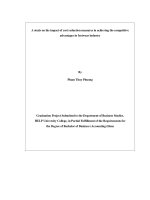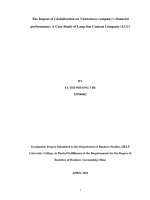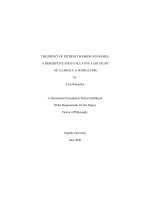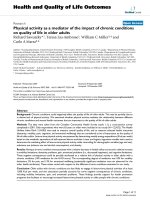On the impact of transcription as a pre listening strategy on EFL learners listening comprehension ability
Bạn đang xem bản rút gọn của tài liệu. Xem và tải ngay bản đầy đủ của tài liệu tại đây (270.17 KB, 5 trang )
On the Impact of Transcription as a Pre-Listening Strategy on EFL Learners’ Listening
Comprehension Ability
[PP: 41-45]
Meresedeh Massahzadeh
Department of English Language, College of Humanities
Islamic Azad University in Rasht, Rasht Branch
Iran
Dr. Majid Pourmohammadi
(Corresponding Author)
Department of English Language, College of Humanities
Islamic Azad University in Rasht, Rasht Branch
Iran
ABSTRACT
This study intended to probe into a kind of precise research over the effect of transcription,
having learners write in advance, and non-transcription based listening tasks on Iranian EFL learners’
listening comprehension. It involved 30 female learners studying EFL at Shokouh English Institute in
Rasht. Their proficiency level was determined by Oxford Quick Placement Test to ascertain that they
were homogeneous. They were then randomly assigned into two groups (control and experimental)
comprising 15 in each. The experimental group received four-week treatment, asking to listen to eight
listening drills taken from ESL-lab listening website earlier in time and transcribe them. Meanwhile,
the control group was asked to listen to the same listening drills offhand without prior transcribing.
Subsequently, learners in both groups answered the oral questions about listening tasks. Having done a
posttest, the results were compared to demonstrate the effectiveness of the treatments in the
experimental group. Based on the findings, having learners to transcribe in advance was useful to
English language teaching methods. In addition, language teachers can utilize transcription as a prelistening strategy to improve their learners’ listening comprehension ability.
Keywords: Intermediate level, Listening comprehension ability, Pre-listening activities, Strategy,
Transcription
The paper received on
Reviewed on
Accepted after revisions on
ARTICLE
INFO
07/05/2018
30/05/2018
28/08/2018
Suggested citation:
Massahzadeh, M. & Pourmohammadi, M. (2018). On the Impact of Transcription as a Pre-Listening Strategy on
EFL Learners’ Listening Comprehension Ability. International Journal of English Language & Translation
Studies. 6(3). 41-45.
1. Introduction
The
importance
of
listening
comprehension in daily communication and
educational process is something worthwhile
to consider. In fact, it is now accepted as the
heart of the language and the most
frequently used language skill in everyday
life (Vandergrift, 2007). Over these last
decades, listening has attracted growing
interest in foreign or second language
learning, leading teachers to look for new
and most importantly practical methods to
maximize the efficiency of their listening
instruction in both EFL and ESL settings.
The importance of listening ability in
the world, and technological advances in
global communication have made listening
by non-natives even more vital (Cahyono &
Widiati, 2009). It is necessary for students
who learn English as a second or FL to
improve their learning abilities of listening.
University exams, school leaving and other
examinations now often include a listening
component, acknowledging that listening
skill is a core component of language
proficiency, and also reflecting the
assumption that if listening is not tested,
teachers will not teach it (Richards, 2005).
EFL learners who are studying
English as a FL have very few opportunities
to hear the real language; they are not,
therefore, accustomed to hearing the
language as produced by the native speakers.
Consequently, students from the countries
like Iran in which English is taught as a FL
frequently
have
great
difficulty
understanding English spoken to them when
they come into contact with native speakers
of the language. Moreover, since
intermediate Iranian EFL learners lack
sufficient background knowledge of English
vocabulary as well as native accent, they are
International Journal of English Language & Translation Studies (www.eltsjournal.org)
Volume: 06
Issue: 03
ISSN:2308-5460
July-September, 2018
required to use pre-listening activities to
better comprehend.
In the line with the above
contentions, the present study aims to
scrutinize that having learners to transcribe
the task in advance gives them time to get
the message, digest and parse the words in
their mind so as to understand them. It also
makes EFL learners aware of many faces of
the pronunciation of English spoken by
native speakers as well as grammatical
structures and equip them harness their
stress, be more attentive, boost their selfawareness and better comprehend that
listening task. Asking for prior transcription,
also gives teachers a more comprehensive
insight around how to deal with learners’
problems, overcome their blind spots, check
understanding and further their learning
process. To fulfill the aims of this study, the
following hypotheses were proposed:
H01: There is not any statistically significant
difference between listening task with and
without prior transcription among Iranian
intermediate EFL learners.
H02: Prior transcribing of listening task does
not have any statistically significant impact
on the Iranian intermediate EFL learners'
listening comprehension ability.
2. Literature Review
Listening is by nature the first
acquired skill by human beings (Hamidi &
Montazeri, 2014). It is a skill in language
proficiency which can directly affect other
skills and be affected by several strategies
(Safarali & Hamidi, 2012). Most people
think that being able to write and speak in a
second language means that they know the
language; however, if they do not have the
efficient listening skills, it is not possible to
communicate effectively (Yildrim &
Yildrim, 2016). In fact, good listening is
built on three basic skills: attitude, attention,
and adjustment. These skills are known
collectively as triple-A listening (Zohrabi &
Sabouri, 2015).
Yaghoubi-Notash and Hamrang
(2014) investigated the effect of transcript
(having text in advance) and non-transcript
listening tasks on Iranian intermediate EFL
learners’ listening comprehension. The
findings of their study proved that transcript
(having text in advance) improves listening
comprehension and ability of learners to
recall information. Additionally, students
learnt that there was also a need to combine
the development of listening ability with the
development of reading skill.
In another study Babaei (2008)
compared the effects of two types of help
options (subtitles and transcripts) in a
multimedia listening unit on EFL learners’
comprehension of an academic lecture. The
experiment revealed that those students who
used video and transcripts obtained a higher
mean score on the comprehension test than
did those who used video and subtitles.
Since no study has focused on the role of
transcription (process of writing) as a prelistening strategy on the L2 listening
comprehension, the research presented here
seeks to explore the gap.
3. Methodology
3.1 Design
The current
study was
an
experimental study in which the participants
of the study were homogeneously selected
and then randomly assigned into two groups
of control and experimental. Only the
experimental group received treatment
whereas the control group received a normal
routine instruction as they always did. In the
following, the participants of the study, the
materials and the data collection and
analysis procedure will be explained.
3.2 Participants
This study involved 30 female
learners (within the age of 15-20) who were
selected from two different branches of
Shokouh Institute in Rasht, Iran. A total
number of 50 learners took a sample of
Quick Placement Test (QPT) and from
among them 30 learners who got the scores
within the range of 28-38 were selected as
the main sample of this study. Then, they
were randomly assigned to two groups of the
experimental and the control, each group
containing 15 participants.
3.3 Instruments
3.3.1 Proficiency test: for the purpose of
homogenizing, QPT by Oxford University
was administered as a proficiency test which
included 60 multiple-choice questions,
vocabulary reading and language use. It was
administered and those who scored 28-38
were selected as the participants of the study
at the intermediate level.
3.3.2 The pretest: the pretest was
administered before the treatments to
consider the initial differences existing
among the groups with respect to their
listening comprehension ability. The
listening test that was administered to the
learners as the pretest included 20 items and
was the listening section of a sample of the
Preliminary English Test (PET) taken from
Cambridge ESOL.
Cite this article as: Massahzadeh, M. & Pourmohammadi, M. (2018). On the Impact of Transcription as a PreListening Strategy on EFL Learners’ Listening Comprehension Ability. International Journal of English Language
& Translation Studies. 6(3). 41-45.
Page | 42
On the Impact of Transcription as a Pre-Listening Strategy… Meresedeh Massahzadeh & Majid Pourmohammadi
3.3.3 The posttest: in the end, the posttest
that was equal in all respects to the pretest
but with a slight difference in subject was
given to the participants. The aim of
exploiting various subjects was controlling
the possible testing effect.
3.4 Data Collection & Analysis Procedures
The pretest of listening was
administered to both groups. After that the
experimental group received treatment.
Learners in the experimental group were
asked to listen to listening comprehension
passages taken from ESL-lab listening web
site in advance and have transcription. Since
it was very important to clearly comprehend
whether the participants understood listening
tasks, each task was played twice. After the
second playing, they were asked to repeat
while listening. Afterwards, the participants
responded to some oral questions about
listening passages which consisted of 40
questions (five questions for each passage)
and that lasted 40 minutes in total. Unlike
the experimental group, students in the
control group were asked to listen to the
same listening task without prior
transcription. Subsequently, learners in the
control group answered the same oral
questions about the listening tasks. The
gathered data were analyzed via an
independent samples t-test between the
scores of the control and experimental
groups and the results from both groups
were compared together as follows.
4. Results and Discussion
The summary of the descriptive
analysis for the data related to the posttest of
the experimental and the control group is
presented in Table 1.
The result of independent samples ttest demonstrated that there was no
significant difference in scores for the
control (M = 13.46, SD = 2.32) and the
experimental group (M = 13.06, SD = 3.17; t
(28) = .39, p = .69, two-tailed) in the pretest.
The magnitude of the differences in the
means (mean difference = .400, 95% CI: 1.68 to 2.48) was small (Eta squared =
0.0054). In other words, the control and
experimental groups were approximately at
the same level of proficiency in terms of
their FL listening comprehension in the
administered test at the beginning of the
study.
In Table 3, the amount of Sig. (2tailed) value was (.03) which is significantly
smaller than the required cut-off of (.05); it
could be concluded that there was a
statistically significant difference in the
means of the posttest scores of listening
comprehension for the control (M = 13.46,
SD = 2.32) and the experimental groups (M
= 13.06, SD = 3.17; t (28) = .39, p = .69,
two-tailed). The magnitude of the
differences in the means (mean difference =
2.40, 95% CI: -3.93 to -.86) was small (Eta
squared = .2665). The findings revealed that
although the two groups were approximately
at the same level of proficiency in terms of
their FL listening comprehension in the
administered test at the beginning of the
study, statistically significant differences
were found for the results of the posttest.
Thus, the first null hypothesis was rejected.
Table 3: The Independent Samples Test for the
Posttest of Listening Comprehension
Table 1: Group Statistics for the Posttest of
Listening Comprehension
As it can be seen, the mean score
obtained from the experimental group
(16.26) that received the treatment is highly
more than that of the control group (13.86).
Table 2: The Independent Samples T-test for the
Pretest of Listening Comprehension
In order to answer the second
research question and to investigate the
participants’ progress within groups, pairedsamples t-tests were run and based on their
results, this improvement was statistically
significant simply for the experimental
group but not for the control group (P
experimental group (listening comprehension test) <
.05, P control group (listening comprehension test) ≥
.05). In other words, the experimental group
that received prior transcription for the
International Journal of English Language & Translation Studies (www.eltsjournal.org)
Volume: 06
Issue: 03
ISSN:2308-5460
July-September, 2018
Page | 43
International Journal of English Language & Translation Studies (www.eltsjournal.org)
Volume: 06
Issue: 03
ISSN:2308-5460
July-September, 2018
listening tasks made a noticeably higher
progression as compared to the control
group in the posttest of listening. Thus, the
second null hypothesis was rejected, too (see
Table 4).
Table 4: Paired Samples Test
These findings are in line with the
results of numerous studies concerning the
valuable use of pre-listening strategies.
According to Marzban and Abdollahi
(2013), dictation as a pre-listening strategy
makes EFL learners aware of many aspects
of the pronunciation of English spoken by
native speakers. Besides, the findings of this
study revealed that using transcription
provided learners an opportunity to be
sensitive toward different aspects of L2
including pronunciation and improved their
listening comprehension ability.
The findings were also consistent
with the results of research study applied by
Rahimi (2008) in which the efficacy of using
dictation via elaborating on grammatical,
phonological, and lexical points in the
passage is approved. He recommended the
use of dictation as a pre-listening strategy in
the classrooms to speed up the learners’
development in regard to the listening
comprehension ability. In his study the use
of dictation was regarded as an assessment
in FL learning.
In the present study like dictation,
transcribing in advance can be considered a
productive learning device which helped
learners having immediate feedback on the
nature of performance through concentrating
on different aspects of language. In addition,
having learners for prior transcription
enabled teachers of English to concentrate
on learners’ deficiencies as the dictation
studies might do.
On the contrary, no study has been
carried out to examine the effect of
transcription as a process of writing in
advance. Until recently all research utilized
transcription as a way of providing learner
texts with the given copy which can be
considered as a product. However, transcript
in this research focused on the process of
writing, which was a novel and constructive
pre-listening strategy.
In fact, although a lot of scholars like
Babaei (2008) and Yaghoubi-Notash and
Hamrang (2014) emphasized on the
significant role of transcript as a facilitator
in terms of listening comprehension, their
findings were not in agreement with the
present study. In the study conducted by
Yaghoubi-Notash and Hamrang (2014),
learners in the experimental group were
asked to listen to listening task with the
given copy as a transcript. However, in this
study, the researcher played the audio and
had listening tasks written so as to
investigate the impact of transcription as a
process. In this case, the researcher tried to
intensify the learnability of different aspects
of language. Additionally, autonomous
awareness and self-correction of learners
were reinforced through writing prior to
main listening.
5. Conclusion
This study provided data that reflect
the essential needs of the classrooms. The
results can also provide help to institution
language teachers. EFL teachers should also
teach their learners how to listen, to reflect
on the process of listening and focus on
using strategies of planning and monitoring.
Learners
need
to
monitor
their
comprehension as they listen; teachers,
therefore, should allow learners listen to the
text several times so that learners can focus
more attentively to different aspects of
language through writing in advance.
As a result of the aforementioned
issues, asking for transcription in advance
helps learners to listen several times and
more carefully in order to recognize and
comprehend words and their meaning as
well as sentence structure. It also provides
learners an opportunity to rehearse more and
become effective listeners. Teachers can
also benefit through this procedure by
finding a more comprehensive perception
around how to deal with learners’ problems,
overcome their blind spots, check
understanding and further their learning
process.
References
Babaie, H. (2008). On the effects of help options
in MCALL programs on the listening
comprehension of EFL learners. Journal
of Teaching English Language and
literature Society of Iran, 2(6), 27-47.
Cahyono, B. Y., & Widiati, U. (2009). The
teaching of EFL listening in the
Indonesian context: The state of the
art. TEFLIN Journal, 20(2), 194-211.
Cite this article as: Massahzadeh, M. & Pourmohammadi, M. (2018). On the Impact of Transcription as a PreListening Strategy on EFL Learners’ Listening Comprehension Ability. International Journal of English Language
& Translation Studies. 6(3). 41-45.
Page | 44
On the Impact of Transcription as a Pre-Listening Strategy… Meresedeh Massahzadeh & Majid Pourmohammadi
Hamidi, H., & Montazeri, M. (2014). Dictionary
of second language acquisition.
Retrieved
from
/>uction-to-sla
Marzban, A., & Abdollahi, M. (2013). The
effect of partial dictation on the listening
comprehension ability of Iranian
intermediate EFL learners. International
Research Journal of Applied and Basic
Sciences, 5(2), 238-244.
Rahimi, M. (2008). Using dictation to improve
language
proficiency. Asian
EFL
Journal, 10(1), 33-47.
Richards, J. C. (2005). Second thoughts on
teaching listening. RELC Journal, 36(1),
85-92.
Safarali, S. K., & Hamidi, H. (2012). The impact
of videos presenting speakers’ gestures
and facial clues on Iranian EFL learners’
listening comprehension. International
Journal of Applied Linguistics and
English Literature, 1(6), 106-114.
Vandergrift, L. (2007). Recent developments in
second and foreign language listening
comprehension
research. Cambridge
Journals, 40(3), 191-210.
Yaghoubi-Notash, M., & Hamrang, M. (2014).
The effect of transcript-aided listening
tasks on Intermediate Iranian. The
Iranian EFL Journal, 27(1), 375.
Yıldırım, S., & Yıldırım, Ö. (2016). The
importance of listening in language
learning and listening comprehension
problems experienced by language
learners: A literature review. Abant İzzet
Baysal Üniversitesi Eğitim Fakültesi
Dergisi.
Zohrabi, M., Sabouri, H., & Behgozin, M.
(2015). The impact of pre-listening
activities on Iranian EFL learner’s
listening comprehension of authentic
English movies. International Journal
on Studies in English Language and
Literature (IJSELL)
International Journal of English Language & Translation Studies (www.eltsjournal.org)
Volume: 06
Issue: 03
ISSN:2308-5460
July-September, 2018
Page | 45









